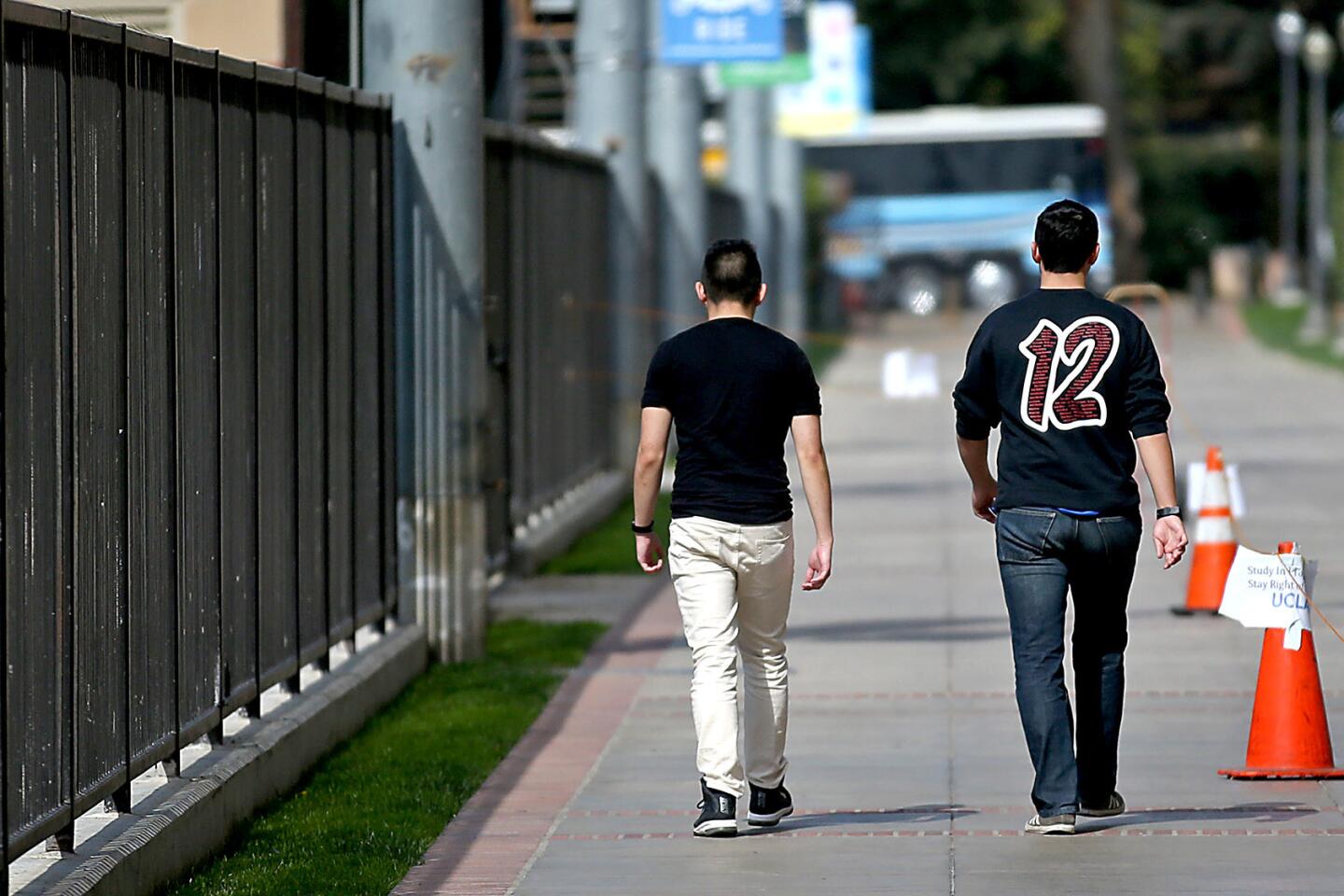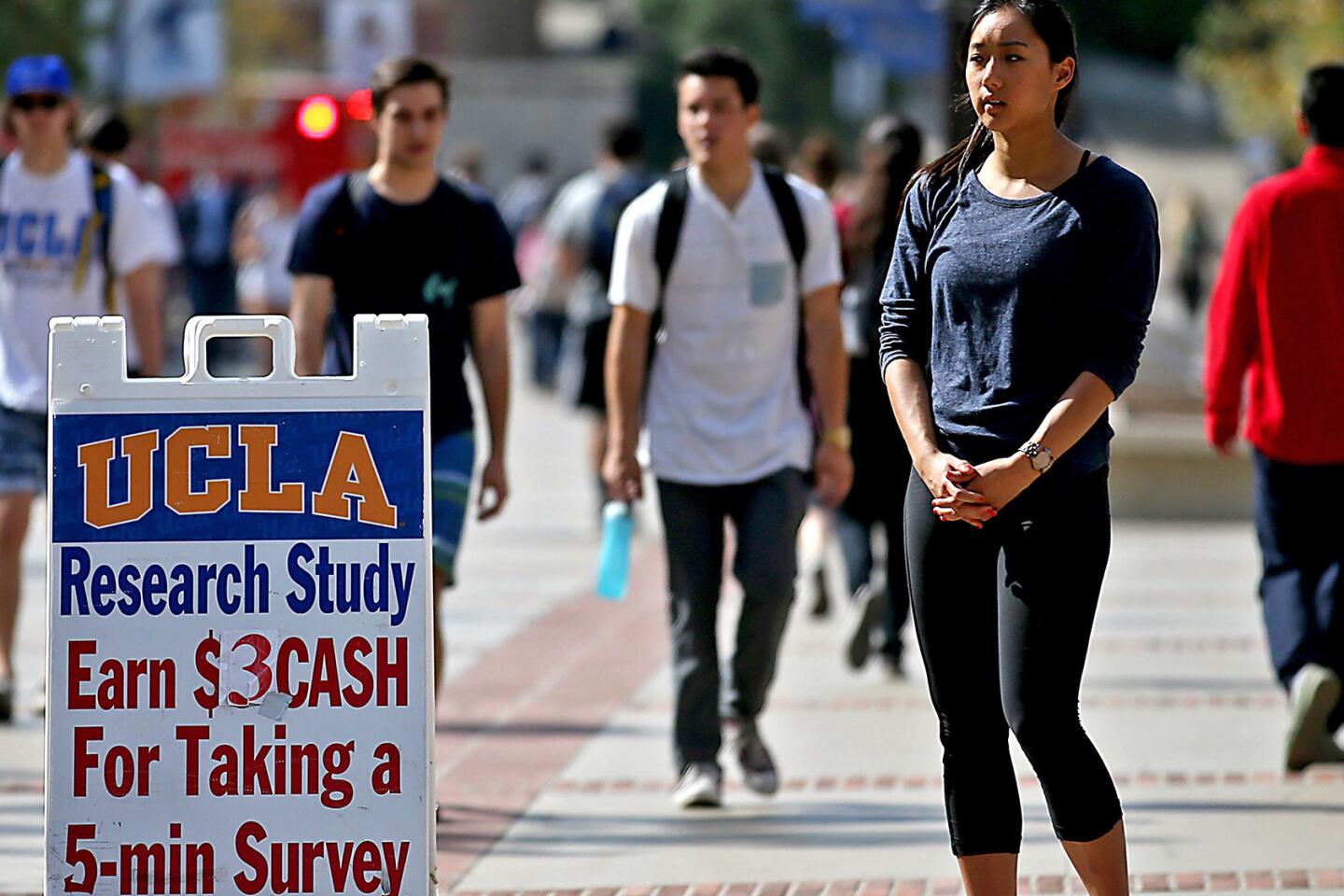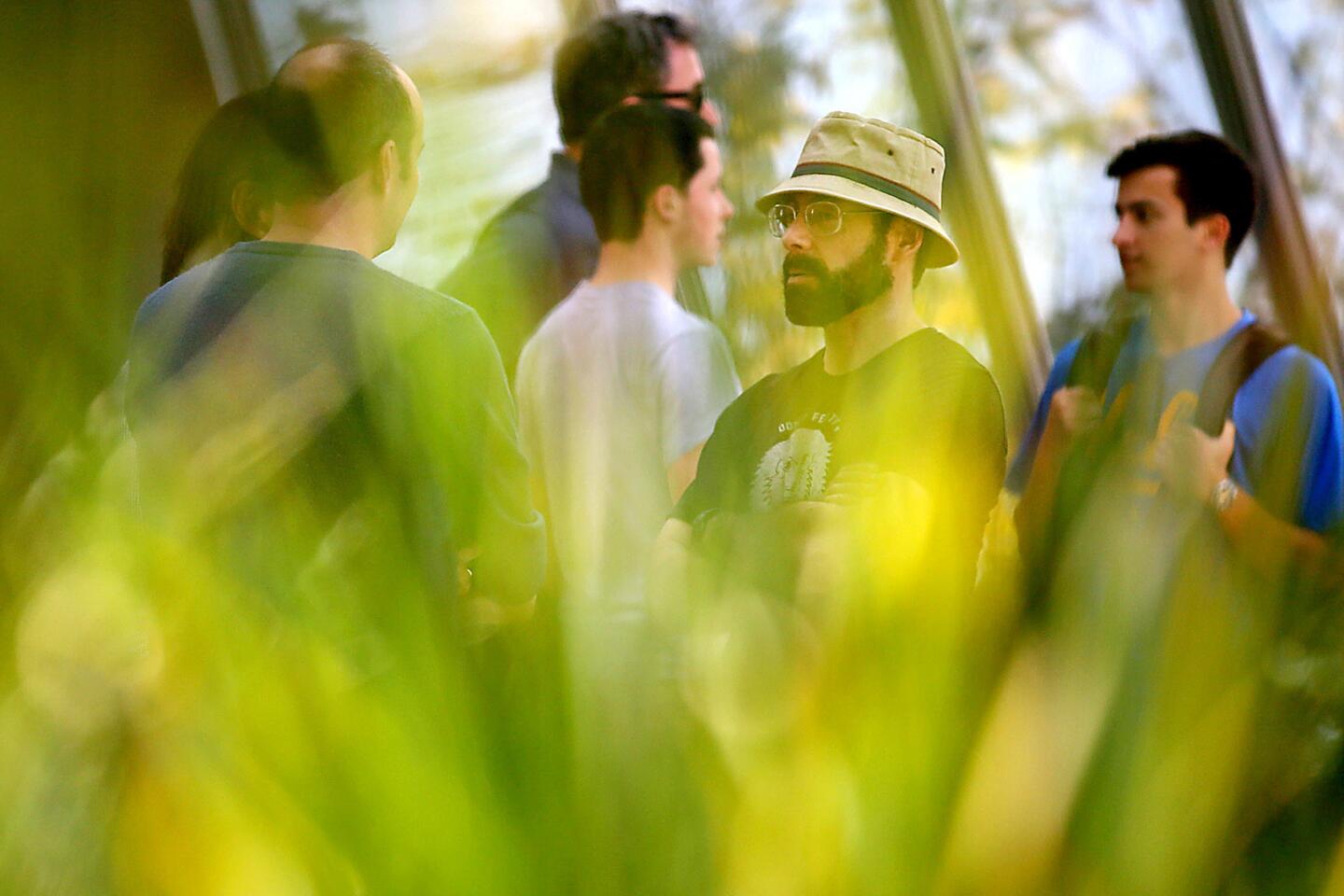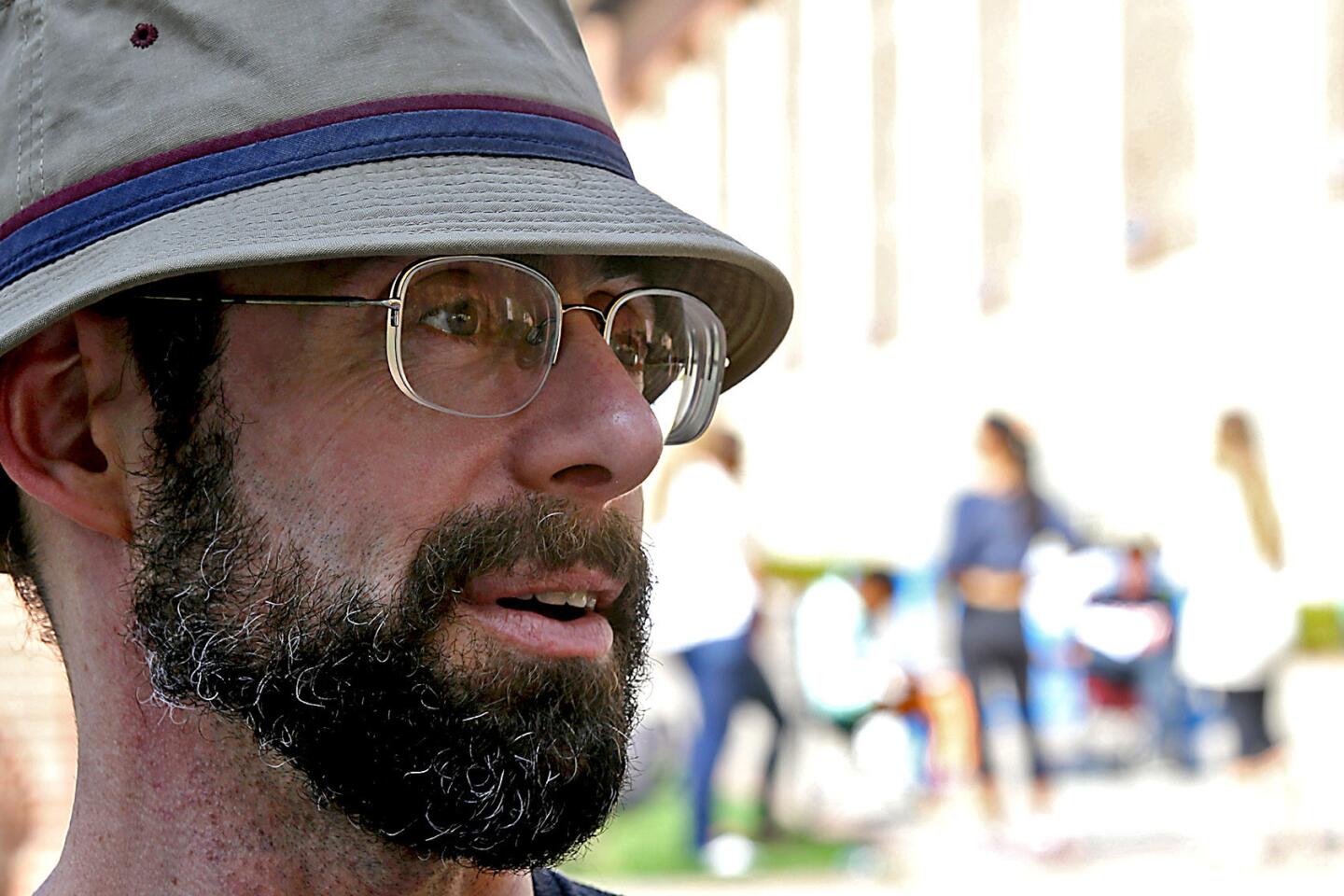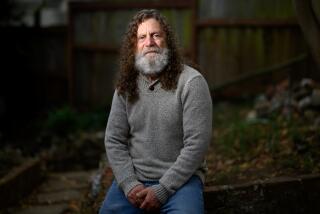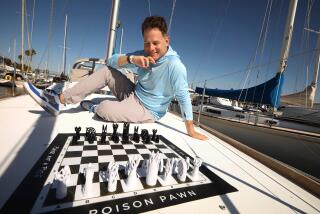Great Read: Men and violence: Sizing up how men size up one another
- Share via
Daniel Fessler is out at UCLA’s Drake Track Stadium to do a bit of discreet academic observation. Spying, really, with a smidgen of fibbing.
It’s fall 2013. Headlines are fading about a Florida jury’s acquittal of a neighborhood watch volunteer who had killed unarmed black teen Trayvon Martin. Just about no one outside of Missouri has even heard of the city of Ferguson.
But Fessler, an associate professor of anthropology at the university, believes he’s uncovering a crude mental shortcut that may shed light on those confrontations and help explain why men resort to violence.
First, his undergraduate research assistants will have to lure male students into doing a strange bit of exercise for $3.
Each volunteer will climb up and down the stadium stairs while holding an electronic metronome and walking to its beat. He’ll do this alongside another student whose metronome may or may not be in sync with his.
Up and down they go. Then they sit on the bleachers and fill out a questionnaire about “the links between motor exertion, visual perception and visual intuition.” (“The best lies are the ones that are true,” Fessler says. “It’s a completely accurate but uninformative description of the study.”)
Fessler isn’t interested in how many colors of jelly beans the volunteer can see in a black-and-white photo of a candy jar — that’s one of the study’s decoy questions. He wants to see how tall or strong the volunteer imagines a “convicted criminal” is, based on a mug shot that looks vaguely like an angry Charlie Sheen.
Fessler expects that those who walked in synchrony with another person will pair the face with smaller, less muscular bodies than those who were out of step. The simple act of walking in unison will make the volunteers feel more formidable against the angry-faced man, he thinks.
Fessler and his postdoctoral assistant, Colin Holbrook, have spent nearly four years chasing the notion that humans, particularly men, super-size or shrink a mental picture of their adversaries and themselves when figuring out whether they can win a potential conflict.
Funded by the Pentagon, which is eager to know what makes men fight and choose sides, the pair have shown that foes “grow” larger when they hold a handgun, or if they’re known to be risk takers (a study dubbed the “Crazy Bastard Theory”). They grow larger if you’re by yourself, rather than in a group. And they may grow larger based on racial biases.
Correctly gauging “relative formidability” probably gave distant ancestors an advantage when only size and muscle mattered. But that mode of reckoning remains in the human mind, like a neurological stone tool hacking at the complexities of human society.
Sometimes, though, stone tools cause trouble in the modern world.
::
The son of molecular biologists, Fessler calls himself “a reductionist, hypothesis-testing scientist” in a field that can be squishy with ambiguity and foggy with speculation.
Wearing a T-shirt with the scowling face of a capuchin monkey, he settles into a narrow office in Haines Hall, where his shelves evoke a used bookstore. A white board scrawled with notes from a half-dozen studies in varied stages of completion looks like a prop from “A Beautiful Mind.” “When people are being nice they say I’m eclectic,” Fessler says, flashing a wry smile.
He may browse the biology of morning sickness one day and the writings of Thomas Jefferson the next, but Fessler regularly returns to the theme of young men and violence. At 51, he casts a clinical eye on his own past: the time he flipped off a driver and got in a roadside tete-a-tete; or when he lived in Sumatra and saw a man die in a knife fight over petty change that wouldn’t have bought a cracker in a local store.
“This stuff is just in there; I’m thinking about it,” Fessler says. “I’ve been thinking about it for a long time.”
So Fessler started the project by looking at men and weapons. Volunteers looked at photos of hands holding either a gun, saw, power drill or caulking gun. Then the volunteers matched the hands to bodies.
The gunman invariably was 2 inches taller than a guy holding a non-threatening implement, even one that requires strength to use.
The researchers don’t think this was a problem with visual perception. “It actually would be kind of crazy in a combat situation to be off in your estimate in size,” Holbrook says.
Rather, it reflects the constant mental calculus that people use to size themselves up vis-a-vis an opponent. “Each time you learn something about the opponent or about yourself that’s relevant to the question of who would win a conflict, you just adjust the size of the little picture in your head,” Fessler adds.
And then you cut a deal, run or fire.
Since the first study nearly four years ago, Fessler and Holbrook have published nine others that hint at the same phenomenon, in ever-more complex situations. Men walking with friends minimized their adversary, compared with men walking alone. Men standing on a balance board or tied to a chair maximized foes relative to the unfettered on terra firma.
Women with children up-scaled male adversaries, compared with solitary women. And solitary women in the fertile part of their menstrual cycles tended to super-size potential foes.
Which brings us to the walkers at Drake Stadium. Fessler suspects it’s no coincidence that “coalitional behavior” is common to armies, riot police and sports teams (not to mention their marching bands). Men in lock step mess with the opponent’s mind.
“The coalition that is well coordinated is going to be more successful in a fight,” Fessler says. “It’s not unique to humans. In animal behavior there is coalitional signaling. Often it involves vocalization. The coyotes all howl.”
Still, Fessler acknowledges, “not every hypothesis is right.”
::
Critics have a problem with the larger hypothesis at hand: that evolution left its mark on psychology.
In their attempt to fuse the humanities with the sciences, evolutionary psychologists manage to enrage practitioners of both. One camp accuses them of reducing humans to biologically determined automatons imprisoned by instinct, the other of dressing up Kipling’s “Just So” parables with a patina of science.
One science blog suggested the “Crazy Bastard” best described the authors. (Fessler shrugs that off with an “Aw, snap!”)
“There are certain aspects of behavior which are adaptations that were expected by the Darwinian process,” says biologist Patrick Bateson, emeritus professor at Cambridge University. “My concern is that the people who talk about these things … don’t really take account of the complexities of behavioral development. An enormous amount of our behavior is influenced by our current environment.”
Fessler counters that “it is completely implausible that natural selection crafted our bodies and it had nothing to do with our minds.” But he also is willing to let the data do the talking.
“It could just be development, and that’s all that there is — there isn’t any evolutionary precursor to it at all,” he said. “I happen to think that’s probably not the case. Either way, we’re just presenting the results.”
By last winter, results of the bleacher experiment looked ambiguous. Fessler and Holbrook puzzled over them with their research assistants. The critique was brutally frank: There wasn’t an adequate control group. Also, the bleacher stairs affect the strides.
So research assistants headed back out this spring, this time on flat ground. The results, published in August, showed men who walked in sync tended to under-size adversaries. Marching made them feel more formidable.
Fessler believes his studies could shed light on confrontations between police and civilians, such as those in Ferguson.
“I’d really like to know whether, when police officers use riot gear, is excessive force more likely?” Fessler says. “They’re all armored up, and all in a line together, in formation, synchronizing behavior.”
Like the study volunteers, police also could be super-sizing black men like Trayvon Martin and Michael Brown, the 18-year-old who was shot to death by an officer in Ferguson in August.
Their latest study, awaiting publication, found that characters in a vignette who had names associated with blacks were rated as bigger than those with Caucasian-sounding names, even though the plots were identical.
“You can use this as a probe to reveal people’s prejudicial stereotypes,” Fessler said.
But Fessler cautions against blaming evolution for biased behavior.
Natural selection, Fessler said, “gives us no insight whatsoever about how people ought to act — only how they do act.”
Twitter: @LATsciguy
